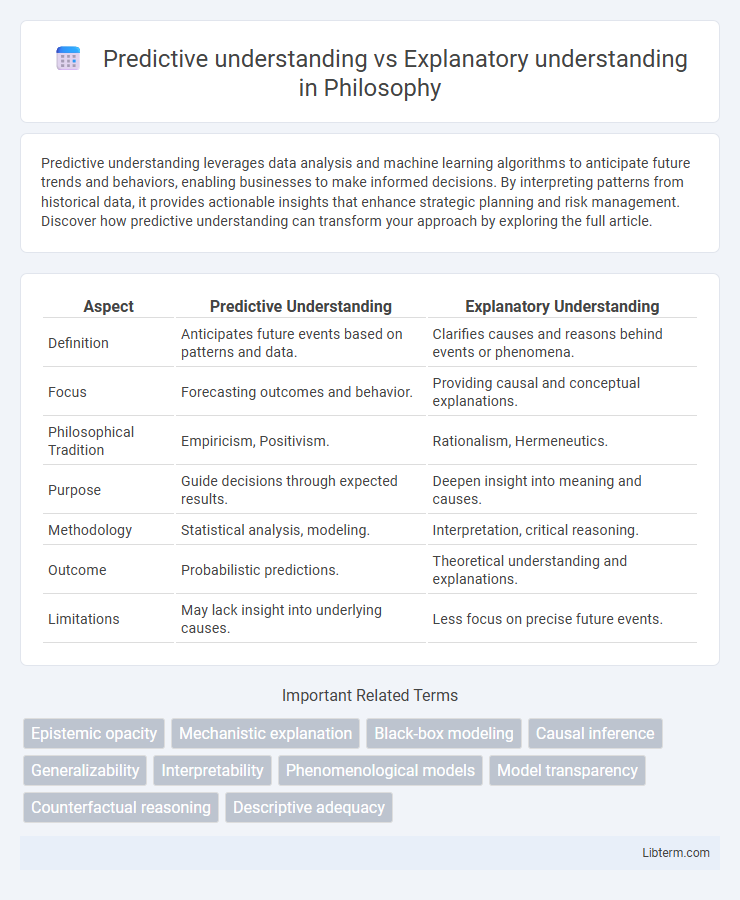Predictive understanding leverages data analysis and machine learning algorithms to anticipate future trends and behaviors, enabling businesses to make informed decisions. By interpreting patterns from historical data, it provides actionable insights that enhance strategic planning and risk management. Discover how predictive understanding can transform your approach by exploring the full article.
Table of Comparison
| Aspect | Predictive Understanding | Explanatory Understanding |
|---|---|---|
| Definition | Anticipates future events based on patterns and data. | Clarifies causes and reasons behind events or phenomena. |
| Focus | Forecasting outcomes and behavior. | Providing causal and conceptual explanations. |
| Philosophical Tradition | Empiricism, Positivism. | Rationalism, Hermeneutics. |
| Purpose | Guide decisions through expected results. | Deepen insight into meaning and causes. |
| Methodology | Statistical analysis, modeling. | Interpretation, critical reasoning. |
| Outcome | Probabilistic predictions. | Theoretical understanding and explanations. |
| Limitations | May lack insight into underlying causes. | Less focus on precise future events. |
Introduction to Predictive and Explanatory Understanding
Predictive understanding emphasizes the ability to forecast outcomes based on patterns and data correlations, relying heavily on statistical models and machine learning techniques. Explanatory understanding seeks to uncover the underlying causal mechanisms and interpretative frameworks that explain why phenomena occur, often using theory-driven approaches and qualitative analysis. Both forms of understanding are essential in data science and artificial intelligence, with predictive models optimizing decision-making and explanatory models enhancing knowledge comprehension.
Defining Predictive Understanding
Predictive understanding involves using data-driven models and algorithms to forecast future events or behaviors by identifying patterns and correlations. This approach emphasizes accuracy in anticipating outcomes rather than explaining underlying causes. Predictive understanding is crucial in fields like machine learning, finance, and healthcare for proactive decision-making and risk management.
Defining Explanatory Understanding
Explanatory understanding refers to the deep comprehension of the underlying causes and mechanisms behind observed phenomena, enabling one to answer "why" questions rather than just "what" or "when." It involves constructing coherent models or theories that provide insight into causal relationships and principles shaping outcomes. This form of understanding is crucial in fields like science and philosophy, where explaining the rationale behind events leads to more robust knowledge than mere predictive capabilities.
Core Differences Between Prediction and Explanation
Predictive understanding emphasizes forecasting future outcomes based on patterns identified in data, while explanatory understanding seeks to uncover the underlying causal mechanisms driving those outcomes. Prediction relies heavily on statistical models and machine learning to generate accurate forecasts without necessarily revealing why events occur. Explanation focuses on causal inference and theory-driven analysis to clarify relationships and provide deeper insights into the phenomena.
Benefits of Predictive Understanding
Predictive understanding enables accurate forecasting of future events by leveraging data patterns and machine learning algorithms, which enhances decision-making efficiency across industries such as finance, healthcare, and marketing. Its ability to anticipate outcomes reduces risks and optimizes resource allocation, driving cost-effectiveness and competitive advantage. By focusing on actionable insights, predictive models facilitate proactive strategies that improve operational performance and customer satisfaction.
Strengths of Explanatory Understanding
Explanatory understanding excels at revealing underlying causal mechanisms and providing insight into why phenomena occur, enabling more robust theory development and deeper comprehension. It supports critical thinking and decision-making by clarifying context and relationships that predictive models alone might overlook. This type of understanding enhances scientific discourse by connecting observations to fundamental principles, fostering knowledge that is transferable beyond specific cases.
Challenges and Limitations of Prediction
Predictive understanding faces challenges such as data quality issues, model overfitting, and the inherent unpredictability of complex systems, which can lead to inaccurate forecasts. Limitations include the difficulty in capturing causal relationships and accounting for unforeseen variables or black swan events. These factors reduce the reliability of predictions, emphasizing the need for cautious interpretation and continual model refinement.
Challenges and Limitations of Explanation
Explanatory understanding often faces challenges such as oversimplification of complex phenomena and the difficulty of establishing causal relationships in dynamic systems. Limitations include the potential for bias in selecting relevant factors and the constrained applicability of explanations that may not generalize beyond specific contexts. Predictive models may outperform explanatory ones in accuracy but lack intuitive insight, highlighting a trade-off between understanding and forecast precision.
Real-World Applications: Prediction vs Explanation
Predictive understanding leverages data-driven models to forecast future events, enabling applications like weather forecasting, stock market trends, and disease outbreak predictions. Explanatory understanding focuses on uncovering causal mechanisms, essential for scientific research, policy-making, and diagnosing problems in engineering systems. Real-world decision-making often balances prediction accuracy with explanatory insight to optimize outcomes and inform strategic planning.
Bridging Predictive and Explanatory Approaches
Bridging predictive and explanatory understanding enhances decision-making by integrating data-driven forecasts with causal insights to improve model interpretability and reliability. Techniques such as causal inference and interpretable machine learning facilitate the alignment of predictive accuracy with explanatory depth, enabling stakeholders to trust and act on model outcomes effectively. This synergy advances fields like healthcare and economics by providing actionable predictions grounded in robust theoretical frameworks.
Predictive understanding Infographic

 libterm.com
libterm.com